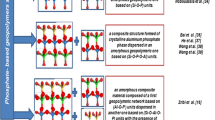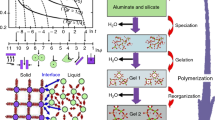Abstract
Spectacular technological progress has been made in the last few years through the development of new materials such as ‘geopolymers’, and new techniques, such as ’sol-gel’. New state-of-the-art materials designed with the help of geopolymerization reactions are opening up new applications and procedures and transforming ideas that have been taken for granted in inorganic chemistry. High temperature techniques are no longer necessary to obtain materials which are ceramic-like in their structures and properties. These materials can polycondense just like organic polymers, at temperatures lower than 100‡. Geopolymerization involves the chemical reaction of alumino-silicate oxides (Al3+ in IV-fold coordination) with alkali polysilicates yielding polymeric Si-O-Al bonds; the amorphous to semi-crystalline three dimensional silico-aluminate structures are of the Poly(sialate) type (-SiO-Al-O-), the Poly(sialate-siloxo) type (-Si-O-Al-O-Si-O-), the Poly(sialate-disiloxo) type (-Si-O-Al-O-Si-O-Si-O-).
This new generation of materials, whether used pure, with fillers or reinforced, is already finding applications in all fields of industry. Some examples:
-
pure: for storing toxic chemical or radioactive waste, etc.
-
filled: for the manufacture of special concretes, molds for molding thermoplastics, etc.
-
reinforced: for the manufacture of molds, tooling, in aluminum alloy foundries and metallurgy, etc.
These applications are to be found in the automobile and aerospace industries, non-ferrous foundries and metallurgy, civil engineering, plastics industries, etc.
Zusammenfassung
Durch die Entwicklung neuer Materialien wie ‘Geopolymere’ und neuer Prozesse wie ‘Sol-Gel’ wurden in den letzten Jahren spektakulÄre Fortschritte auf technologischem Gebiet erzielt. Neue, mittels Geopolymerisationsreaktionen erzeugte Stoffe eröffnen neuartige Anwendungen und verÄndern Ansichten, die in der anorganischen Chemie seit langem als gesichert galten. Hochtemperaturtechniken sind nicht mehr notwendig, um Materialien herzustellen, die in ihren Strukturen und Eigenschaften der Keramik gleichen. Solche Substanzen können, Ähnlich wie organische Polymere, bei Temperaturen unterhalb 100‡C polykondensieren. Geopolymerisation beinhaltet die chemische Reaktion Alumino-silicatischer Oxide (Al3+ in Viererkoordination) mit Alkali-Polysilicaten zu polymeren Si-O-Al Bindungen; die amorphen bis semi-kristallinen dreidimensionalen Silicoaluminatstrukturen sind vom Poly(sialat) Typ (-Si-O-Al-O-), vom Poly(sialat-siloxo) Typ (-Si-O-Al-O-Si-O-), vom Poly(sialat-disiloxo) Typ (-Si-O-Al-O-Si-O-Si-O-).
Diese neue Generation von Materialien, ob in reinem Zustand, mit Füllstoffen oder in verstÄrkter Form, finden gemÄss zitierten Beispielen bereits Anwendungen in allen industriellen Bereichen. Dazu gehören insbesondere die Automobil- und Luftfahrts-Industrie, Giessereien und Metallurgie von Nichteisenmetallen, Ingenieurwesen, Kunststoffindustrie, etc.
Similar content being viewed by others
References
J. Davidovits, Darstellung und Strukturuntersuchung von Diol-oligo-urethanen einheitlicher Molekügrösse, Dr. rer. nat. Thesis, University of Mainz, Germany, 1960.
J. Davidovits, Transfer and Exploitation of Scientific and Technical Information, EUR 7716, Commission of the European Communities, Luxembourg 1982, p. 316.
R. M. Barrer, Trans. Brit. Ceramic. Soc., 56 (1957) 155.
D. W. Breck, Zeolite Molecular Sieves, J. Wiley & Son ed., New York 1974.
J. Davidovits, SPE PACTEC '79, Society of Plastic Engineers, Brookfield Center, USA 1979, p. 151.
J. Davidovits, Concrete International: Design & Construction, 9 Nℴ 12 (1987) 23.
R. Weiss, Chemische Rundschau, 39 (Nov. 21) (1986) 1.
P. Moch, P. Thebaut, L. Girardot and M. Davidovics, Geopolymer '88, paper nℴ 10, Université de Technology Compiègne, France 1988.
J. Orlinski, Geopolymer '88, paper nℴ 9, Université de Technologie Compiègne, France 1988.
M. Guigon et J. L. Meyer, Geopolymer '88, paper nℴ 16, Université de Technologie Compiègne, France 1988.
J. Davidovits, Geopolymer '88, paper nℴ 2, Université de Technologie Compiègne, France 1988; see also Proceedings of Geopolymer '88, Vol. 1, p. 25; Vol. 2, p. 149.
J. Davidovits, Geopolymer '88, Vol. 2, p. 149.
J. Davidovits, US Patent 3.950.470, French Patent 2.204.999, French Patent 2.346.121; UK Patent 1.518.605; J. Davidovits and J. J. Legrand, US Patent 4.028.454, French Patent 2.324.427.
J. Davidovits, J. Lavau et A. Emberger, French Patent 2.341.522.
R. M. Barrer and J. W. Baynham, J. Chemical Soc., (1956) 2882.
J. Davidovits, European Patent 026.687, European Patent 066371, US Patent 4.349.386, USA Patent 4.472.199.
E. Lippmaa, M. Megi, A. Samoson, G. Engelhardt and A. R. Grimmer, J. Phys. Chem. Soc., 102 (1980) 4889.
D. Müller, W. Gressner, H. J. Behrens and G. Scheler, Chem. Phys. Lett., 79 (1981) 59.
B. H. W. S. De Jong, C. M. Schramm and V. E. Parziale, Geochemica et Cosmochimica Acta, 47 (1983) 1223.
J. Klinowski, Progress in NMR Spectroscopy, 16 (1984) 237.
W. Loewenstein, Am. Mineral., 39 (1954) 92.
Z. Gabelica, J. Davidovits and H. J. Jakobsen, Geopolymer '88, Vol. 1, paper nr 8, p. 6.
M. Davidovics, J. Orlinski and J. Davidovits, Tooling for Composites Conference, Anaheim, USA, June 1990, Society of Manufacturing Engineers SME.
C. Boutterin and J. Davidovits, Proceedings 22nd Symposium on Archeometry, University of Bradford, U.K. 1982, p. 213. See also French Patent 2.490.626 (1982).
D. C. Comrie, Report CANMET Canada, DSS Contract Nℴ 234406-9195/01SQ, Preliminary examination of the potential of geopolymers for use in mine tailings management, D. Comrie Consulting Mississauga, Ontario, 1988.
J. Davidovits, European Patent 338.060 (PCT WO 89/02766), US Patent Application 104.190, 1987.
J. Davidovits and D. Comrie, Preprints Division Chemistry, Am. Chem. Soc., Toronto, (1988) 237.
J. Davidovits, SPE PACTEC '83, Society of Plastic Engineers, Brookfield Center, USA 1983, p. 222.
Chemical & Engineering News, Washington D. C. March 5, 1990, p. 13.
Report, Projet Matériaux 1982, P. 0548, Ministère de la Recherche, Paris 1985.
N. Davidovits, M. Davidovics and J. Davidovits, US Patent 4.888.311, European Patent 288.502 (PCT WO 88/02741).
J. Davidovits and M. Davidovics, ICCM & ECCM, Elsevier Applied Science, London 1987 Vol. 1, p. 462.
NICALON is registered trademark of Nippon Carbon & Co. Japan
SAFIL is a registered trademark of I.C.I. Ltd, UK.
J. Davidovits and M. Davidovics, Ceramic Eng. Sci. Proc., 9 (1988) 835.
Author information
Authors and Affiliations
Rights and permissions
About this article
Cite this article
Davidovits, J. Geopolymers. Journal of Thermal Analysis 37, 1633–1656 (1991). https://doi.org/10.1007/BF01912193
Issue Date:
DOI: https://doi.org/10.1007/BF01912193




